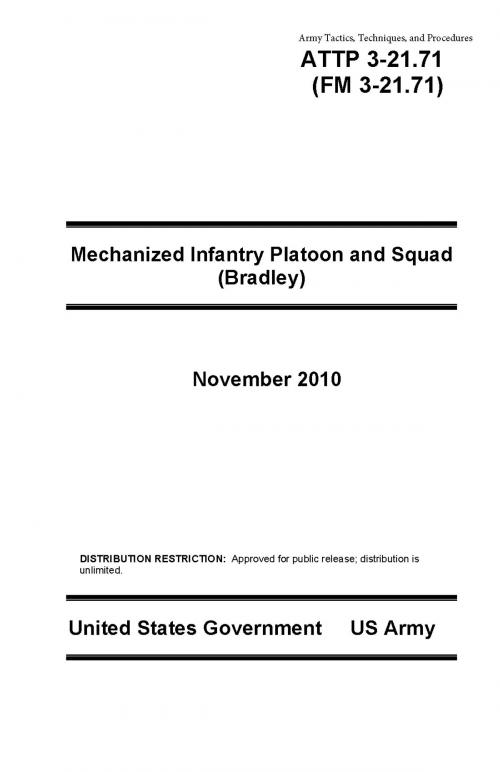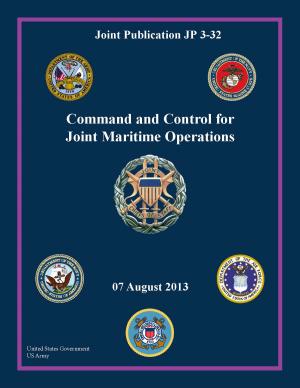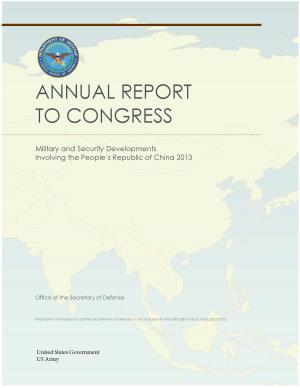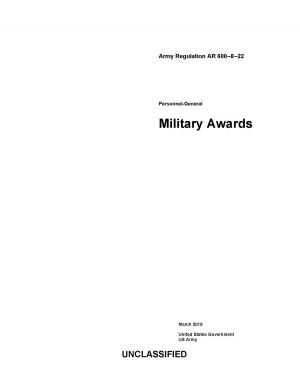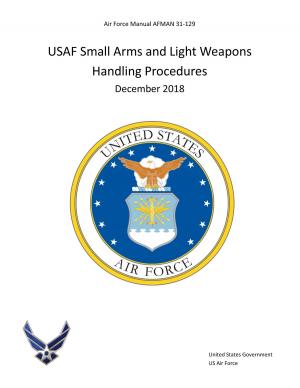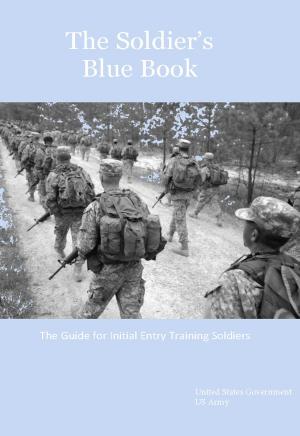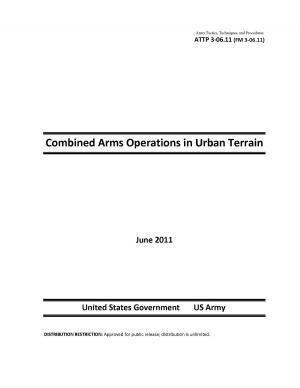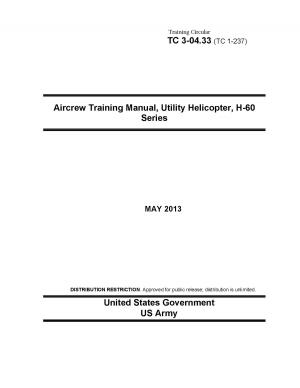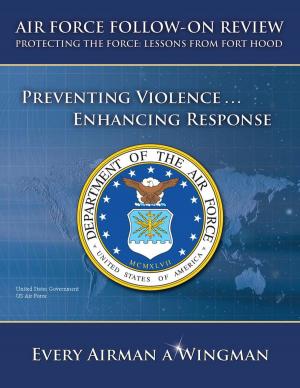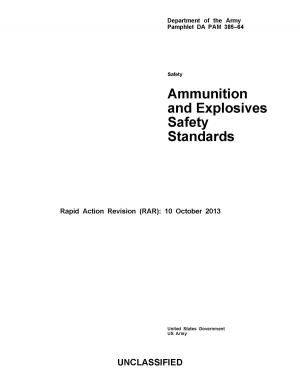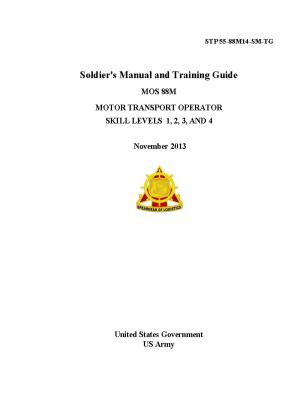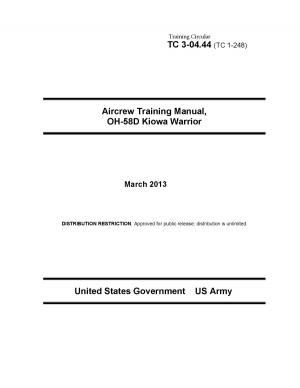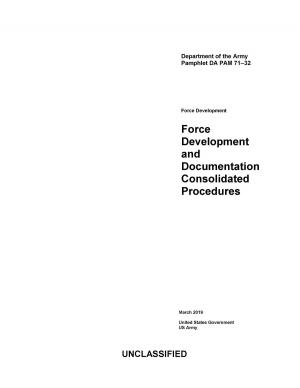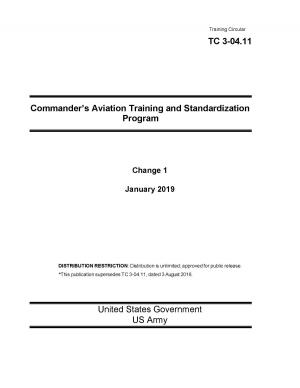Army Tactics, Techniques, and Procedures ATTP 3-21.71 (FM 3-21.71) Mechanized Infantry Platoon and Squad (Bradley) November 2010
Nonfiction, Reference & Language, Study Aids, Graduate & Professional, Armed Forces, History, Military, United States, Reference, Guides & Handbooks| Author: | United States Government US Army | ISBN: | 1230000125761 |
| Publisher: | eBook Publishing Team | Publication: | April 19, 2013 |
| Imprint: | Language: | English |
| Author: | United States Government US Army |
| ISBN: | 1230000125761 |
| Publisher: | eBook Publishing Team |
| Publication: | April 19, 2013 |
| Imprint: | |
| Language: | English |
This manual provides a doctrinal framework for the Bradley Fighting Vehicle (BFV) equipped Infantry rifle platoon and squads. It addresses the BFV and all variations, rifle platoon and squad combat and noncombat operations, across the spectrum of conflict. Content discussions include principles, tactics, techniques, procedures, terms, and symbols that apply to small unit operations in the operational environment.
This manual is not intended to be a stand-alone publication and is intentionally designed as a companion manual to FM 3-21.8, The Infantry Rifle Platoon and Squad. Many of the subjects covered in FM 3-21.8 are not only mutually applicable to the mechanized platoon and squads but also are nearly identical and need not be republished. Because of this, ATTP 3-21.71 focuses on the unique characteristics and capabilities of the mechanized platoon and squads. Major areas not included or reduced in this manual that are covered in detail in FM 3-21.8 include:
• Movement and maneuver.
• Patrols.
• Chemical, biological, radiological and nuclear (CBRN) operations.
• Employing fires.
• Employment of the dismounted element’s weapons.
• Platoon and squad fire planning.
• Troop-leading procedures (TLP).
• Air assault operations.
• Sustainment.
• Urban operations (UO).
• Air defense.
• Improvised explosive devices (IED).
• Composite risk management.
• Obstacle reduction and employment.
• Fratricide avoidance.
• Dismounted fighting positions.
• Sniper operations.
These are basic skills that mechanized small units and their leaders must understand, practice, and execute. Their absence or reduction of information from this manual in no way diminishes their importance. Rather, they are fundamental skills applicable to all Infantry units and leaders.
To fully understand operations of the mechanized rifle platoon and squad, leaders must have an understanding of FM 3-90.1, Tank and Mechanized Infantry Company Team, and FM 3-90.5, Combined Arms Battalion. The primary audience for this manual comprises the mechanized Infantry rifle platoon leaders, platoon sergeants, and squad and fire team leaders. The secondary audience includes instructors in U.S.
Army Training and Doctrine Command (TRADOC) schools, writers of Infantry training literature, other Infantry leaders and staff officers, and Reserve Officer Training Candidate (ROTC) and military academy instructors.
Leaders should use this manual as a set along with the publications listed in the References. The Summary of Changes lists major changes from the previous edition by chapter and appendix. Although these changes include lessons learned from training and U.S. Army operations all over the world, they are not specific to any particular theater of war. They apply across the entire spectrum of conflict.
This publication applies to the Active Army, the Army National Guard (ARNG)/Army National Guard of the United States (ARNGUS), and the United States Army Reserve (USAR) unless otherwise stated.
The proponent for this publication is the United States Army Training and Doctrine Command. The preparing agency is the U.S. Army Maneuver Center of Excellence (MCoE).
This manual provides a doctrinal framework for the Bradley Fighting Vehicle (BFV) equipped Infantry rifle platoon and squads. It addresses the BFV and all variations, rifle platoon and squad combat and noncombat operations, across the spectrum of conflict. Content discussions include principles, tactics, techniques, procedures, terms, and symbols that apply to small unit operations in the operational environment.
This manual is not intended to be a stand-alone publication and is intentionally designed as a companion manual to FM 3-21.8, The Infantry Rifle Platoon and Squad. Many of the subjects covered in FM 3-21.8 are not only mutually applicable to the mechanized platoon and squads but also are nearly identical and need not be republished. Because of this, ATTP 3-21.71 focuses on the unique characteristics and capabilities of the mechanized platoon and squads. Major areas not included or reduced in this manual that are covered in detail in FM 3-21.8 include:
• Movement and maneuver.
• Patrols.
• Chemical, biological, radiological and nuclear (CBRN) operations.
• Employing fires.
• Employment of the dismounted element’s weapons.
• Platoon and squad fire planning.
• Troop-leading procedures (TLP).
• Air assault operations.
• Sustainment.
• Urban operations (UO).
• Air defense.
• Improvised explosive devices (IED).
• Composite risk management.
• Obstacle reduction and employment.
• Fratricide avoidance.
• Dismounted fighting positions.
• Sniper operations.
These are basic skills that mechanized small units and their leaders must understand, practice, and execute. Their absence or reduction of information from this manual in no way diminishes their importance. Rather, they are fundamental skills applicable to all Infantry units and leaders.
To fully understand operations of the mechanized rifle platoon and squad, leaders must have an understanding of FM 3-90.1, Tank and Mechanized Infantry Company Team, and FM 3-90.5, Combined Arms Battalion. The primary audience for this manual comprises the mechanized Infantry rifle platoon leaders, platoon sergeants, and squad and fire team leaders. The secondary audience includes instructors in U.S.
Army Training and Doctrine Command (TRADOC) schools, writers of Infantry training literature, other Infantry leaders and staff officers, and Reserve Officer Training Candidate (ROTC) and military academy instructors.
Leaders should use this manual as a set along with the publications listed in the References. The Summary of Changes lists major changes from the previous edition by chapter and appendix. Although these changes include lessons learned from training and U.S. Army operations all over the world, they are not specific to any particular theater of war. They apply across the entire spectrum of conflict.
This publication applies to the Active Army, the Army National Guard (ARNG)/Army National Guard of the United States (ARNGUS), and the United States Army Reserve (USAR) unless otherwise stated.
The proponent for this publication is the United States Army Training and Doctrine Command. The preparing agency is the U.S. Army Maneuver Center of Excellence (MCoE).
